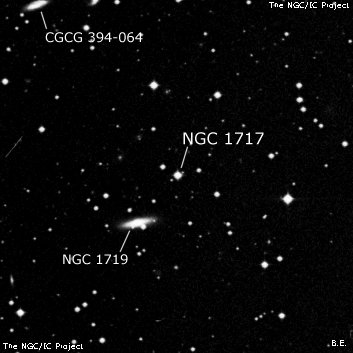NGC/IC Project Restoration Effort
(This is a very very beta version)
NGC1717


Basic Information
Location and Magnitude
Right Ascension: 4:58:44.0
Declination: -0:28:40
Constellation: ORI
Visual Magnitude: 14.2
Historic Information
Discoverer: Stoney J.
Year of discovery: 1849
Discovery aperture: 72.0
Observational
Summary description: np h 340 (? F *)
Sub-type: S0
Corwin's Notes
=====
NGC 1717. Dreyer gives 04 56 36, -00 19.2 (B1950.0) as the NGC position of
this object, giving the RA to a full minute of time only, marking it "+-".
There is nothing at all in that place, not even a faint star. So, the
identity of this NGC entry is not known with certainty. However, we do know
that it is either a star, or it is NGC 1709. Here is the story.
Reading through Lord Rosse's descriptions of N1719 (bear with me here), it
looks as if the "3 vF neb" seen on 15 Jan 1845 are NGC 1709, 1713, and 1719.
This assumes that Dreyer's comment "The two upper (sic) ones are probably h339
(N1713) and h340 (N1719)" is meaningful and correct. This would probably
point to N1709 as the third nebula -- but what does Dreyer mean by "upper"?
The northern-most or (assume an inverted field) the southern-most?
LdR goes on to say that d'Arrest, in his observation of N1719, has a star
13-14 4.7s p, and 80" north (as, indeed d'A does, along with a detailed
description in Latin that I must translate one of these days). This must be
the object that Dreyer is refering to in NGC when he says "(? F *)." There
are two other stars, one perhaps double, in the same area. So, it is possible
that one of these was mistaken by LdR as a faint nebula (many other of the
stars to receive NGC numbers are also from LdR's observations).
LdR looked again at NGC 1719 on two other nights, and could find no trace of a
nebula northwest of it. So, it may be possible that he mistook NGC 1713
for NGC 1719 on that first night. Since there is a galaxy northwest of N1713
-- NGC 1709 -- this hypothesis would then make NGC 1717 = NGC 1709, as I
suggested above.
Since there were no other observations of the area published before the NGC
appeared, we are left with four candidates for N1717. All but NGC 1709 are
stars northwest of NGC 1719. Two of those stars are bright enough to be in
GSC. Here are the positions (B1950.0) of all three stars:
04 56 52.2 -00 19 16 HCo Slightly elongated image -- perhaps double?
04 56 45.91 -00 18 11.2 GSC
04 56 56.55 -00 18 42.9 GSC Brightest of the three -- most likely
candidate star.
So, we are left with a puzzle. There may be other relevant observations in
the post-NGC literature, but it's unlikely that they will help sort out this
particular problem.



